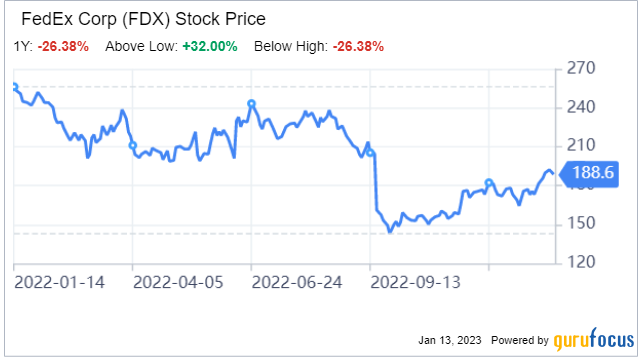FedEx Corp. (FDX, Financial) has been what is called dead money for about five years now, down 30% since 2018 and shedding $25 billion off its market value.
In September, after the company announced first-quarter 2023 results and cut its outlook, CEO Raj Subramaniam told CNBC’s Jim Cramer that the economy is likely to enter a worldwide recession. He was one of the first Fortune 100 CEOs to do so.
A couple of weeks later, the stock was down 23%, pushing the market cap below $37 billion, very close to its Covid-19 lows.
Fast forward a few months and, while the stock has traded higher, there is still enough margin of safety to get involved.
The FedEx brand is still strong
FedEx’s brand continues to be top of mind to its customers. The intangible value is likely worth more than $48 billion alone even if the company might struggle to control costs and competition in the short term.
In fact, in December, FedEx shared its plans to reduce expenses by another $1 billion in 2023 to approximately $3.7 billion due to declining demand and operational issues. To achieve these savings, the company will discontinue Sunday delivery service outside of most densely populated areas in the U.S. At least some of that should be attributed to the bottom line, but the courier company has maintained that delivering on Sundays is a competitive advantage. If it is a costly one, however, that is not a real advantage.
FedEx operates with only one real competitor - United Parcel Service Inc. (UPS, Financial). Sure, Amazon.com Inc. (AMZN, Financial) continues to build its own delivery network, but that would only hurt UPS. Plus, there will still be plenty of space in the delivery business for all three.
The company's express and ground package delivery operations have a significant cost advantage and efficient scale, and the high barriers to entry in shipping and logistics make it nearly impossible to compete against. Assuming Amazon keeps its package delivery in-house, FedEx is likely to produce solid returns on capital for the foreseeable future. Two things are likely to happen: customers will ship more products and shipping rates will increase to meet inflation and costs.
Even if customers begin to demand more convenience (i.e., faster delivery), FedEx offers same-day options in metro areas covering a 45 mile distance to destination. This also applies to freight, which is available in all 50 states for delivery within hours. In other words, I think FedEx is still well positioned from a business standpoint.
FedEx versus UPS
While FedEx's stock is down 30% in the last five years, UPS's stock is up 41%. Further, it pays out 3.3% of its earnings as a dividend versus FedEx's 2.40%. However, FedEx is priced at one-third of the industry leader, yet has very similar financials.
UPS generates $11 billion a year in net earnings on $23.6 billion in gross profit and $101 billion in revenue. FedEx generates a very similar amount of gross profit ($23 billion) on slightly lower revenue of $94 billion, but less of that gets pushed to the bottom line. FedEx’s net income was just $3.3 billion in the last 12 months.
The problem lies in the costs and debt, which is what FedEx is trying to alleviate by stopping Sunday delivery to nearly 50% of its service area. The company spends around $6 billion more in operating expenses than UPS. The latter is in a better financial position with $11 billion in cash and $23 billion in total debt. In comparison, FedEx has net debt north of $31 billion, which admittedly is a pretty hefty amount compared to its net earnings and total cash of $4.6 billion.
If UPS is fairly valued, then FedEx has a pretty significant upside where if the strategic cost cuts work, these two companies could be back on par financially.
Fear, uncertainty and doubt
There are several factors that could work against the company. First, the cost savings could fall short or cause service issues. Shipping rates may have to be stable despite other expenses rising. Further, FedEx’s premium pricing could evaporate in the future as competitors in local markets could become more prominent.
These factors are also justified in the current economic environment for all of the top competitors. Does that mean UPS or Amazon will force FedEx out of the market? No way.
It is true these two industry leaders are competing for the same business and that UPS seems to have a competitive advantage looking just at the financials. However, consumers run businesses and UPS certainly does not have 3 times the brand power that FedEx does, even if it currently earns three times more. Remember, both companies deliver a very similar number of packages each year (6.5 billion) and are quantitatively equal on a financial basis. UPS has just done a better job focusing on profits.
What is likely to happen is this. FedEx will reduce costs close to what it anticipates. Some or most will go to Ebitda and improve earnings. The company will continue to buy back stock and earnings per share will go up.
If FedEx is successful, that means adding more to the bottom line and boosting the market capitalization back above $100 billion, a 100% jump from its current price. I would be shocked if in five years (barring some really horrific event globally) FedEx was trading at these levels.


